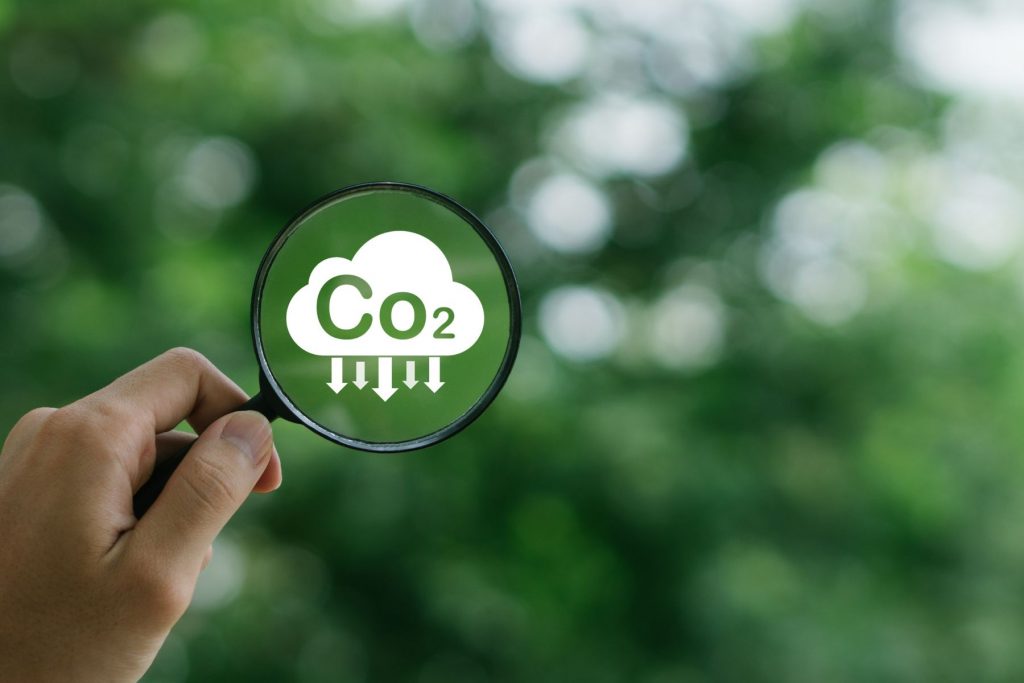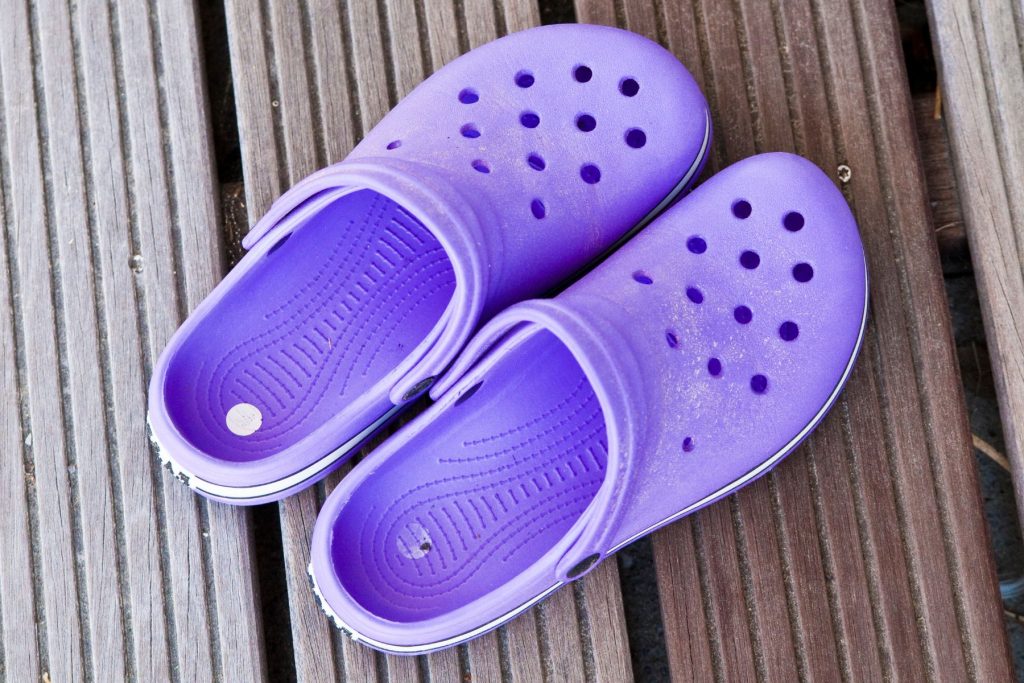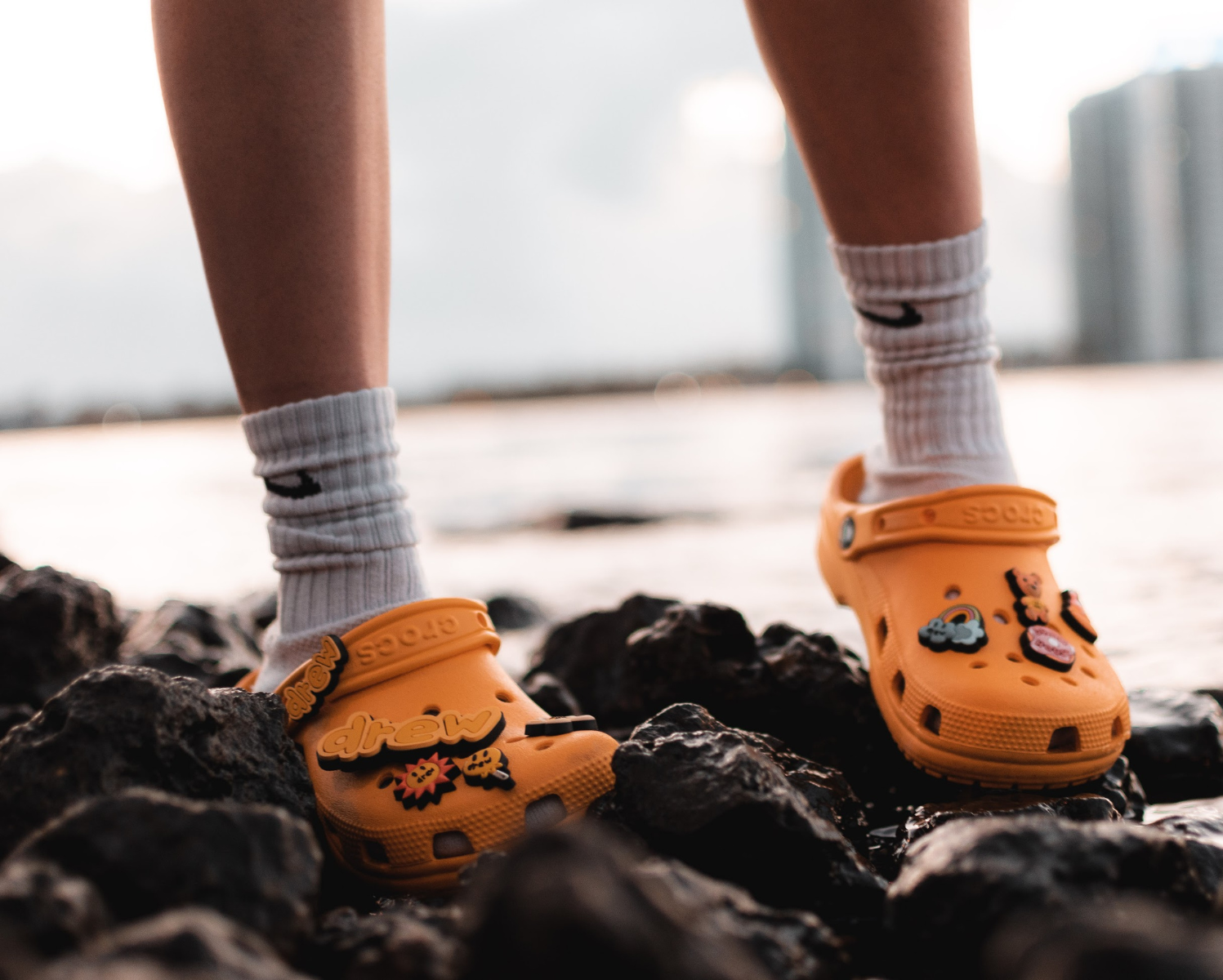The once unusual footwear brand Crocs has entered the forefront of fashion to now be a staple for many. From once being uncool and something just for children, the shoe is now widely owned and worn by all. I, too, own a pair as an adult, having owned several pairs as a child. Comparing revenue from the first quarter of 2022 and 2023, income increased by 33.9% as popularity of the brand grew once more.
But what has made Crocs so popular once again?
- Social media and Endorsement – Since 2022, Crocs have increased in popularity on social media, becoming the new footwear ‘trend’. This fashion trend has not gone unnoticed by celebrities and influencers and has resulted in Croc collaborations/endorsements. Some notable partnerships include, Balenciaga x Crocs, Crocs x Justin Bieber, and even Crocs x KFC. Women’s Crocs | Balenciaga® United Kingdom, Crocs X Justin Bieber with drew SOLD OUT! | Crocs Official Site, KFC® x Crocs™ | Crocs™ Official Site.
- Comfort and Versatility – Crocs are soft, lightweight and durable thanks to the material used called Croslite. The material also moulds to your feet the more you were them. Crocs were originally made for boating and are therefore waterproof and easy to clean too!
- Customisation – Not only are Crocs available in many colours, styles, and limited editions, but they can also be customised/personalised with ‘Jibbitz’. These are little badges that can be secured into the shoe with many different designs, appealing to all.
Crocs have certainly become the new desirable shoe, but do customers really know what they are purchasing, and the environmental impact Crocs have? It is time to ask, what the croc?
What is the impact of Crocs on the environment?

- Croslite: How it’s made – The material used to make Crocs, Croslite, is made from Ethylene Vinyl Acetate (EVA) and is what gives the shoe the ‘rubbery’ flexibility. However, EVA is sourced from crude oil which is obtained from deep underground or the seas floor using oil rigs. The process of gathering crude oil is extremely harmful to the environment. It releases harmful pollutants and chemicals into both the air and water and can even lead to oil spills. In 2019, the UK was responsible for 13.1 million tonnes of CO2 emissions from one North Sea oil rig. Oil rigs are responsible for noise pollution harming sea mammals that rely on sound to communicate and navigate their surroundings.
- Petroleum – Croslite is distributed to Crocs manufacturers using petroleum, along with usual transportation methods of coal and oil. Like other fossil fuels, petroleum is one of the culprits of dangerous carbon emissions and accounts for 90% of the world’s transportation needs.
- Water waste – During Crocs production, excessive amounts of water are used to cool the moulds. In the locations where Crocs are manufactured, there have been water shortages due to this. If Crocs are not reused, they are incinerated and emptied into water channels contaminating the water and contributing to further CO2 emissions.
How is the Crocs brand responding?
In response to growing concerns for the future of the environment, Crocs have released an initiative called ‘A more comfortable world for all’ which aims at ‘comfort for the planet, comfort for our communities, and comfort for all people’. But how are they doing this and what are their goals?

- Circularity – ‘Achieving 50% bio-circular content within the Croslite material by 2030’. This would involve moving away from fossil fuel reliance to renewable resources.
- Climate – ‘Achieve net zero emissions by 2040 and reduce carbon footprint by 50% of classic clog by 2030’.
- Responsibility – ‘All factories and suppliers complete social compliance audits’. This would enable further insight into the supply chain that is not normally shared.
- Community – Consider ‘local, regional, social, and environmental realities’ and working to protect all those involved in the brand.
- Inclusivity – Considering people at every point, being ‘delightfully democratic’ and ‘confidently comfortable’.
Soles4Souls Initiative: As part of their commitment to sustainability, Crocs has developed a recycling programme to provide a new home for pre-loved Crocs. By doing so, the organisation is preventing shoes in good condition from ending up in landfill and going to those in need. How does it work you ask?
Have you got a pair of old Crocs you do not want anymore? Crocs too small? You can now recycle them for free and even get a discount for a new pair – What the Croc!!!
How to do it:
- Head to Google and type in Crocs Recycling Programme which will take you to their website: Crocs Recycling Program – Get a 10% Discount! | Crocs
- Scroll to ‘Ready to Do Good Together’ and order your free mailing kit.
- Send back your Crocs and receive a 10% discount off a new pair.
- Once received, any Crocs that are still in good conditions are donated to Soles4Souls, a not-for-profit organisation supporting those in developing countries.
Sounds good right? If you have a pair of Crocs sitting somewhere forgotten about, why not recycle them using the Soles4Souls initiative. Not only are you supporting sustainability through a circular economy but also supporting social sustainability.
Is it enough?

Time for the important question – are Crocs doing enough to combat their environmental impact?
“Crocs, you know, they’re indestructible, which causes a sustainability issue” (Scienceline, 2022). The brand is heavily reliant on consumers recycling their pre-loved clogs in order to embrace a circular economy. However, we know that this does not, and will not, always happen. Those that are not recycled will end up in landfill. Crocs are not biodegradable and will take hundreds of years to decompose.
The organisation claims to be committing to using 50% renewably sourced plastics as opposed to fossil fuels by 2030. This would include a new bio-based plastic called Ecolibrium made from plant-based materials like crude tall oil as an alternative to traditional fossil fuels. It is sourced from by-products of other production processes like paper making. As of August 2024, Crocs have reached the 25% milestone with 5 years left to go until we reach 2030. Crocs have seen a 3% decrease in overall emissions, and 6.1% decrease per pair produced.
What do consumers think?
In December 2024, the organisation ‘Good on you’ provided a sustainability rating as they do for many popular brands: Crocs – Sustainability Rating – Good On You. They commented that Crocs’ efforts are “a start” but “not good enough”. They justified their rating based on:
- Use of lower impact materials – Good
- No evidence of microplastic minimisation – Bad
- No evidence of protecting biodiversity – Bad
- No evidence of water use reduction – Bad
General consumers seem to not have much knowledge of the environmental impact of Crocs and the repercussions of their production. Based on my research, it is clear that the consumer is distracted by the trendiness of the brand and unique footwear that is so versatile we see them in everyday life. They do not truly know the story behind what they are buying, and Crocs are not doing enough to inform the consumer.
What do you think? Are Crocs doing enough?
Thanks for reading!
By Maddie Polston, SGO Projects Officer
Fancy some extra reading? Here are some useful links:
- Why Are Crocs So Popular? (Reasons Are Surprising) – Freaky Shoes®
- How Crocs Turned an “Ugly” Shoe into a High Trendy One | by Madame Vision | Medium
- Crocs — Design Life-Cycle
- Ethylene Vinyl Acetate (EVA) – Plastribution
- Oil and Gas Development | Threats | WWF
- UK North Sea oil rigs release as much CO2 as coal-fired power station – study | Oil | The Guardian
- Petroleum | WWF
- Crocs (CROX): PESTEL and Macro-Environmental Analysis – Hivelr
- Crocs, Inc. –
- Crocs achieves 25% ‘bio-circular’ material across portfolio… and leaves a few questions | Products of Change
- What Crocs are made of — and how they’re changing
 Sustainability
Sustainability Bethany Climpson
Bethany Climpson 6257
6257


